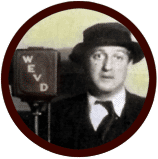 |
||
|
|
||||||||||||||||||||||||||||||||||||||
|
The Yiddish Radio DialYiddish was the language of the more than two million Jewish immigrants who came to the U.S. from Eastern Europe at the turn of the twentieth century. As the last great wave of these arrivals landed at Ellis Island in the 1920s, radio was beginning its ascent in American culture. The recent Jewish immigrants embraced the medium, and by the early 1930s, Yiddish radio flourished nationwide. In New York alone, 23 stations broadcast dramas, variety programs, man-on-the street interviews, music, commercials, even editorials in rhyme. The shows ran the gamut of radio genres, but they all shared one important feature: intimacy. "On Yiddish radio," explains Yiddish radio historian Henry Sapoznik, "no one was bigger than life. Everyone was life. It was a one-to-one ratio between the listeners and the characters on the radio. Listeners didn't want a window to look out into another world; they wanted a mirror to see their own." Yiddish radio obliged. There were the searing dramas of Nahum Stutchkoff, which grappled with the difficult reality of Jewish immigrant experience; the mediation program of Rabbi Samuel A. Rubin, who resolved disputes among Jews too poor or disempowered to turn to the civil courts; the advice show of C. Israel Lutsky, whom many listeners trusted more than their rabbi; and the talent shows that turned the microphone to anyone in the neighborhood courageous enough to let his or her voice be aired. The best-remembered and most powerful of all the Yiddish radio stations was WEVD. Created in 1927 by the Socialist Party to honor its recently deceased leader, Eugene Victor Debbs, the station was taken over in 1932 by the leading Yiddish newspaper, The Forward. The Forward created the most famous Yiddish radio program of all time -- The Forward Hour, a variety show that aired every Sunday morning at 11:00. Ironically, while hours of relatively obscure programs like Madame Bertha Hart's Talent Show have survived, only a few random moments of The Forward Hour remain. Among them is the show's remarkable theme song, with its musical allusions to the Socialist anthem "The Internationale" and "La Marseillaise." Further down the dial were micro stations like WBBC, WVFW, and WARD, which fought one another tooth and nail to control frequencies and wattage hardly powerful enough to reach around the corner. Program directors for these stations sometimes had to fill as many as four hours of air-time a day by themselves. Such was the predicament of the inimitable WLTH program director Victor Packer, who probably took more chances and experimented with more genres than anyone in the history of broadcasting. Yiddish radio reached its apex in the early 1940s and was in near free fall by the mid '50s. Radio's loss of prestige to television was only part of the reason. The Holocaust had forever stemmed the flow of Yiddish speakers to America, while many earlier arrivals turned away from Yiddish culture as they assimilated in the New World. Israel's choice to make Hebrew its official language further marginalized Yiddish as the language of modern Jewish life. Given the fate of the Yiddish language and the unstable recording materials used in the 1930s to early '50s, it is a miracle that any remnant of the "golden age" of Yiddish radio has survived to see the present day. Next Page: Rediscovering the Remnants of Yiddish Radio »
|
|||||||||||||||||||
| Copyright 2002 Sound Portraits Productions. All rights reserved. | |||

